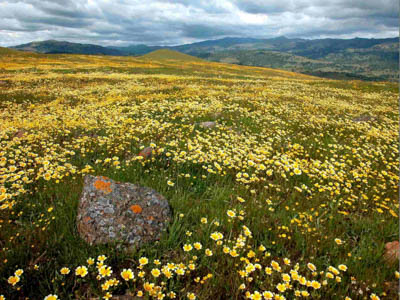Campus News
New study shows how loss of drought-sensitive species could affect health of California grasslands
At a grassland site near San Jose, scientists studied experimental research plots to determine what might happen if the plants that ecologists expect to be hit hardest by drought actually disappeared.

A recent study published in the journal Proceedings of the National Academy of Sciences shows how the health of a California grassland might be affected in a future with less biodiversity and a changing climate, particularly in the case of more frequent droughts.
Erika Zavaleta, a professor of ecology and evolutionary biology at the University of California, Santa Cruz, and Amelia Wolf, an assistant professor of integrative biology at The University of Texas at Austin, created experimental plots at a site near San Jose that contained a typical mix of native plants, minus those that are most sensitive to drought, to determine what would happen if the plants that ecologists expect to be hit hardest by drought actually disappeared.
The team used a 30-year dataset of plant surveys to determine which species did poorly during drought years, and they based their decisions of which species to exclude from their plots on those data. Their findings showed that, absent the drought-sensitive plants, the remaining plants in the plots grew less—a result known as lower productivity—than corresponding plants from another set of experimental plots where some species had been randomly excluded.
These results show how biodiversity loss field experiments that mimic “realistic species loss” can reveal greater impacts on ecosystems than more traditional study designs, where ecologists select species to remove at random. The research team ran their experiment for three years: during a wet year, a normal year, and a drought year. Even during drought years, the drought tolerant plants that were left behind in the plots with realistic species loss didn’t grow as big as their counterparts in the traditional plots.
Another critical ecosystem function, the ability to resist invasive species, varied widely from year to year over the course of the experiment. This suggests that complex interactions between species traits and varying climate have great influence in these outcomes.
Overall, the study’s findings could help to inform conservation strategies and lead to more accurate predictions about what ecosystems will look like in the future.
“We’re building a framework to understand what losing species means,” Zavaleta said. “That gives conservation managers an opportunity to anticipate and to manage ecosystems to preserve certain species and also to mitigate for declines in other species.”
The researchers are now working on a follow-up study to determine whether their results apply more broadly to other ecosystems around the world.
“Species have important impacts within an ecosystem, and they have effects that we can quantify — and if some species are gone, ecosystems will change in a quantifiable way,” Wolf said. “Some of these changes might not be noticeable to most people, but many of these changes are likely to be consequential for humans.”
Other authors of the study are Jennifer Funk, of the University of California at Davis; Paul Selmants, of the U.S. Geological Survey; Connor Morozumi, of Emory University, Daniel Hernández, of Carleton College; and Jae Pasari, of Portland State University. This work was supported by the National Science Foundation.